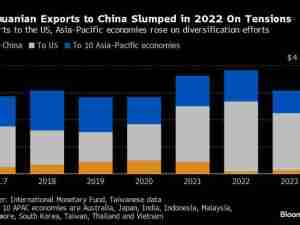Russian markets froze on Monday and traders struggled to price the ruble as international sanctions shook the country’s financial system.
The Russian currency lost a third of its value in offshore trading at one point, its biggest-ever slump. Quotes were infrequent and volatile at the start of the session, and traders warned that low liquidity was making it difficult to match buyers and sellers. The central bank canceled local trading altogether in stocks and bonds as the price of Russian-linked shares and debt tumbled overseas.
In a bid to shield the economy from the toughest foreign penalties deployed to date, the central bank hoisted the key rate to 20%, introduced mandatory hard-currency revenue sales for exporters, and banned foreigners from selling Russian securities, before ruble trading began after a three-hour delay.
A massive gap formed between rubles quoted in Moscow and prices in international markets at the open. The dislocations were unprecedented in recent memory for a market as big as Russia and underscored how trading is being upended as investors rush to sell.
Concerned whether ruble forward contracts would be delivered, traders turned to the non-deliverable forwards market. There, one-month contracts surged to a record 31,317 points, corresponding to a currency level of 113.02 per dollar. That compared with a spot price of 109.89 in the offshore market, which itself was trading weaker than the onshore price at 98.80 per dollar.
“There’s so little liquidity that pricing data we can see at the moment doesn’t really mean anything,” said Paul McNamara, a fund manager at GAM Investments. “People are struggling to get out of forwards because no one can tell what will happen in the next month. We think most foreigners have reduced but not eliminated their exposure.”
Elsewhere, London-headquartered Standard Chartered Plc took the decision not to quote the ruble or rates with any bank sales counterparty, according to an internal memo to staff reviewed by Bloomberg News. “This is a conservative approach, based on the fact we can’t know who end client may be,” the memo read, saying the measure was in place “until there is further clarity on the impact and scale of international sanctions.”
The bank declined to comment on the note when contacted by Bloomberg.
The emergency moves by the central bank came amid a concerted global move to block the Russian regulator from using its $640 billion of foreign reserves as a backstop for the currency and the economy. Still, according to to Renaissance Capital, the central bank measures should be sufficient to hold the ruble around 100 rubles per dollar and to keep local currency available to companies and citizens—assuming foreign governments don’t escalate by moving to restrict Russia’s crucial commodity exports.
At one point on Monday, the ruble was listed at 117.933 per dollar in offshore quotes compiled by Bloomberg. The weakest level hit in Moscow trading was 109.185. The ruble was down 16% at 98.2350 as of 5:59 p.m. in Moscow, compared with 107.0642 on the offshore market—a 22% loss.
Sanctions have effectively “closed Russia’s capital account,” said Peter Kinsella, global head of foreign-exchange strategy at Union Bancaire Privee in London. “This means you’re likely to end up with huge differences between offshore and onshore pricing. This is a new paradigm for the ruble.”
The curtailed trading is set to continue. The Bank of Russia announced there will be no morning or evening sessions on the Moscow Exchange from March 1-5. The ruble session will running from 10 a.m. to 7 p.m. local time and the central bank will decide later whether to open other market sectors, it said.
The decision to block brokers from executing foreign investors’ sell orders was “the final blow” and “clearly a riposte to the weekend’s western sanctions,” said Christopher Granville at TS Lombard.
“The calamity of Russia’s war in Ukraine has put an end to international financial investing in Russia.”




